About Ringing
Ringing can seem baffling to the outsider, but with a little explanation, it all starts to fit into place. This page should remove some of the mystery, so read on ...
Did you know? :
How a bell works
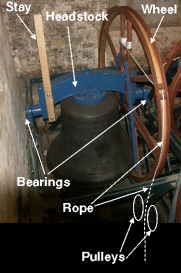 English style ringing is also called 'full circle ringing', and evolved in England about 400 years ago. The style of ringing, and the way the bells are hung, are intimately connected, and evolved together. The bell and wheel are both mounted on the headstock, which is free to rotate. The bell is shown here mouth down, at rest, but when ringing, it swings through 360 degrees from mouth-up to mouth-up and back again.
English style ringing is also called 'full circle ringing', and evolved in England about 400 years ago. The style of ringing, and the way the bells are hung, are intimately connected, and evolved together. The bell and wheel are both mounted on the headstock, which is free to rotate. The bell is shown here mouth down, at rest, but when ringing, it swings through 360 degrees from mouth-up to mouth-up and back again.
The rope is attached to the wheel, passing round it and down through a pulley block to the ringing room many feet below. The rope is all that connects the ringer below to the bell above. It wraps alternately each way round the wheel, so that the rope is in tension as the bell comes to rest at the end of each swing, and the ringer can control it by exerting more or less force as required. See an animation of bell and ringer in action.
 The diagram shows the position of the bell and rope at each stroke. Less rope is wound round the wheel at handstroke than at backstroke (see arrows). As a result the ringer has surplus rope at handstroke, and therefore holds the 'sally' - the fluffy coloured part some way from the rope end. The sally dissapears through the ceiling each backstroke in the animation.
The diagram shows the position of the bell and rope at each stroke. Less rope is wound round the wheel at handstroke than at backstroke (see arrows). As a result the ringer has surplus rope at handstroke, and therefore holds the 'sally' - the fluffy coloured part some way from the rope end. The sally dissapears through the ceiling each backstroke in the animation.
The bell can be rested when it is mouth up, with the stay resting against the a slider bar underneath the bell. It slides in order to let the bell go just beyond the balance point in each direction. The slider bar, seen end on in the diagram, moves about a foot, within a slot in the runner board (shown grey).
The clapper strikes on opposite sides of the bell at each stroke. As the bell comes to rest, the clapper keeps going, so it strikes the leading edge each time.
See also how bells are made .
Ringing in sequence
Ringing many bells in sequence is the essence of the English style (in contrast to the random sounds that are traditional in many parts of the world). Full circle ringing makes this possible, because you can accurately control the timing when each bell strikes. When swinging up near the balance point, the bell no longer behaves like a pendulum (whose period of swing is fixed). The time it takes the bell to swing varies with how high it swings - swing a little higher and it rings more slowly, swing a little less high and it rings more quickly. So it is possible for each ringer to adjust the speed of his or her bell to fit in exactly with the others, and therefore ring in sequence. It is also possible to vary the speed of individual bells by larger amounts, in order to vary the order of the bells from one sequence to the next, and add variety is the. This is the essence of change ringing .
There is a physical limit to how much the timing can be varied between successive swings of a bell, so we still can’t play ‘tunes’ in the normal sense. If you do hear tunes coming from a tower, then they are being played on static bells, either by a machine, or manually from a keyboard.
Bell music
Almost all rings of bells have notes in a diatonic scale. The key varies with the weight of the bells (heavier bells are deeper toned) but ringers don't refer to the actual notes when ringing. The bells are numbered from the lightest bell (number 1) also called the Treble, down the scale to the heaviest bell, also called the Tenor. For simplicity, there are no key signatures on the diagrams here, but if you are a musician, assume they all use the Treble clef, and show a ring of bells with Tenor in C.
 The most basic sequence is 'Rounds', where the bells ring after each other running down the scale, and this pattern is then repeated as long as required. It is shown here with 8 bells, but Rounds can be rung on any number of bells. All ringing normally starts and ends with Rounds.
The most basic sequence is 'Rounds', where the bells ring after each other running down the scale, and this pattern is then repeated as long as required. It is shown here with 8 bells, but Rounds can be rung on any number of bells. All ringing normally starts and ends with Rounds.
By way of variation to continuous Rounds, 'Call Changes' (or Called Changes) periodically swap adjacent pairs of bells in the sequence to produce different sequences. There are several popular sequences that most ringers instantly recognise, and most of them show some sort of regular 'pattern' when viewed in musical notation. Here is a sample.
- Queens - Down all the odd numbers, then down the even numbers. It is said that Queen Elizabeth I thought it beautiful, when she heard it being rung at St Michael's Cornhill. It is also believed to have been called 'thirds', which is the musical interval between each note on the downward runs.
- Whittingtons - Up the odd numbers and down the evens (on 6 bells). It is alleged that Dick Whittington heard this when he was leaving London, and that the six notes seemed to say 'Turn a-gain Whitt-ing-ton', but that seems questionable.
- Tittums - There are two ways to look at this. Either the tune goes up and down from note to note, with an overall downward drift, or it is two sequences: a slow progression down the high notes (1-4) interleaved with a slow progression down the low notes (5-8). This interleaving also appears in method ringing (see below). The name is onomatopoeic - The alternating high and low notes sounding 'ti tum ti tum ti tum ti tum'.
- Roller Coaster - Upward runs of three, moving progressively lower after each run. Both the shape of the music, and the sound, evoke the idea of a roller coaster ride.

Queens on 8 |

Whittingtons 0n 6 |

Tittums on 8 |
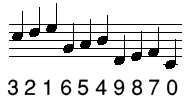
Roller Coaster on 10 |
Listen to this There are many other named call changes .
See also more information about music in ringing .
Changeringing methods
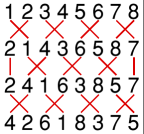 Method ringing is much more dynamic than call changes, because the sequence changes continually. The inertia of the bell imposes physical limitations on the speed at which bells can change places, so an individual bell never moves more than one place at once in the sequence, but within this constraint, most of the bells change place most of the time.
Method ringing is much more dynamic than call changes, because the sequence changes continually. The inertia of the bell imposes physical limitations on the speed at which bells can change places, so an individual bell never moves more than one place at once in the sequence, but within this constraint, most of the bells change place most of the time.
The diagram shows four successive sequences, with the red lines showing the changes between the rows. The crosses show a pair of bells swapping place, and the straight lines show a bell staying in the same place. Alternating these two changes ('all pairs swap', and 'all except end ones swap') generates 16 rows all different (on 8 bells) before returning to Rounds. It is called a Plain Hunt'
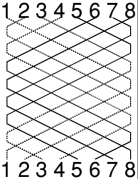
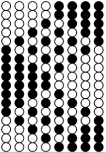 Instead of writing down all the numbers, imagine that lines have been drawn through where each bell is in each successive row, and then the numbers removed just leaving the lines. It produces a pattern like the one on the left (squashed up to take less space). The first and last row of numbers have been left in, so you can follow each line and see that it ends in the right place. You should be able to see that the path of each bell is part of the same continuous pattern, but with each bell starting at a different position on the line. The overall pattern is like plaiting, using the paths of the different bells instead of three strands of hair.
Instead of writing down all the numbers, imagine that lines have been drawn through where each bell is in each successive row, and then the numbers removed just leaving the lines. It produces a pattern like the one on the left (squashed up to take less space). The first and last row of numbers have been left in, so you can follow each line and see that it ends in the right place. You should be able to see that the path of each bell is part of the same continuous pattern, but with each bell starting at a different position on the line. The overall pattern is like plaiting, using the paths of the different bells instead of three strands of hair.
The picture on the right shows the same thing, but with bells 1-4 (the high notes) shown as white blobs and bells 5-8 (the low notes) as black blobs. As the high notes and low notes move from left to right and vice versa, they interleave with each other. This interleaved effect is a characteristic feature of bell music, especially on larger numbers of bells.
Method names
Changeringing methods have names. They are less baffling if you know how they work. Like plant names they have three parts, for example 'Plain Bob Doubles', 'Norwich Surprise Minor', 'Kent Treble-bob Maximus'.
- The first part is the specific name, given by the first band to ring the method in a peal (or an extent on fewer than 7 bells). Methods are often named after places, but they can be named after many other things as well. Some names are quite whimsical.
- The second part is the type. This is to do with the way the method is constructed. It can get rather technical, but if you want to know more, look at Section (E) B of the CC Decisions . Some methods miss out the second part, for example 'Stedman Triples'.
- The third part is a family name based on the number of bells. For odd numbers, it describes the maximum number of pairs that can swap. So for example 5 bells: 2 pairs max = Doubles, 7 bells: 3 pairs max = Triples. The names for 9 and 11 come from the French, and were used as numbers in cards and dice during the 17th century when changeringing was developing.
The names for methods with different numbers of bells are shown below, along with the maximum possible number of different changes that can be rung (called an 'extent') and the time it takes to ring them all. This has never been done on more than 8, for obvious reasons!
| Bells |
Name |
Max number of changes |
Time to ring |
------|------ |
Bells |
Name |
Max number of changes |
Time to ring |
| 3 |
Singles |
6 |
¼ min |
| |
4 |
Minimus |
24 |
1 min |
| 5 |
Doubles |
120 |
5 min |
| |
6 |
Minor |
720 |
25 min |
| 7 |
Triples |
5040 |
3 hour |
| |
8 |
Major |
40,320 |
Nearly a day |
| 9 |
Caters |
362,880 |
1 week! |
| |
10 |
Royal |
3,628,800 |
Even longer!! |
| 11 |
Cinques |
39,916,800 |
|
| |
12 |
Maximus |
479,001,600 |
|
| 13 |
Sextuples |
6,227,020,800 |
|
| |
14 |
14 in |
87,178,291,200 |
|
| 15 |
Septuples |
1,307,674,368,000 |
|
| |
16 |
16 in |
20,922,789,888,000 |
|
If you want to know whether a method with a given name exists, look in the Method database .
Learning & ringing methods
Change ringing can get a lot more complex than just ringing a Plain Hunt, but the complexity is less than you might imagine, once you learn to see the patterns, and then the patterns within the patterns.

 Here is one very simple example. If the last change in the plain hunt is replaced with a different one, the sequence does not end there, but continues. If instead of the first and last bells staying in the same place, the first and second bells do (ie replacing the top change shown here with the bottom one) and the whole thing is then repeated, it will go seven times (112 changes) before getting back to Rounds. This produces a method called Plain Bob. (Plain Bob Major shown here, but the same principle applies to any member of the family.) Once again, ringers don't learn all the numbers, they look for patterns. The path of one bell of Plain Bob Major is shown at the right (different bells start at different places along the same line).
Here is one very simple example. If the last change in the plain hunt is replaced with a different one, the sequence does not end there, but continues. If instead of the first and last bells staying in the same place, the first and second bells do (ie replacing the top change shown here with the bottom one) and the whole thing is then repeated, it will go seven times (112 changes) before getting back to Rounds. This produces a method called Plain Bob. (Plain Bob Major shown here, but the same principle applies to any member of the family.) Once again, ringers don't learn all the numbers, they look for patterns. The path of one bell of Plain Bob Major is shown at the right (different bells start at different places along the same line).
Can you see the pattern?
More complicated methods have more complex patterns, but they yield to similar mental tactics for learning them.
Performances - courses, touches, quarter peals and peals
Changeringing performances start and end with a short period of Rounds, in between which the sequences continually vary according to the rules of the method(s) being rung. The simplest thing to do is to ring a 'plain course' of a method. That runs for a set length (which depends on the method) and returns to Rounds automatically at the end.
The ringing can be varied to make it longer (or sometimes shorter) by calling a 'touch'. At key points, the conductor makes a call ('Bob' or 'Single') that alters the sequence at that point. Think of the plain course as going round a race circuit, and the call as making the bells turn onto a different, intersecting circuit at that point, but with the new circuit having identical length and shape to the original. At the next call, the bells make a similar switch to another circuit, and so on. Unlike a race circuit, this is not constrained to a flat surface, so most of the different circuits only intersect a few of the others. If the touch is correctly composed, and accurately called, the bells never pass along the same part of any circuit twice, and in due course return to the original circuit containing Rounds, and the touch ends. For general ringing, when there are more ringers present than bells, and when different people ring in each touch, the touches are normally quite short, from a few minutes up to maybe 15. This avoids those who are not ringing in any particular touch sitting out for long periods.
For longer performances, the bands are pre-arranged with one person per bell. The commonest is a 'quarter peal', which typically takes between 40 and 50 minutes to ring. Less common is a peal, which has 5000 or more changes, and takes between 2½ and 4½ hours, depending on the weight of the bells. In fact on 7 or fewer bells, the length must be 5040 (which is the maximum possible on 7 bells, see table above). See also Peals at All Saints Wokingham .
The success of a peal or quarter peal attempt is not guaranteed. That may come as a surprise to anyone familiar with conventional musical performances. See explanation ,
Performances across the world are routinely recorded on BellBoard, a searchable online database that shows what was rung, who rang and often a picture of the ringers.
You can see What's been rung at All Saints
These notes are based on the talks about bellringing that we give to local groups. If your group would like a talk, please contact us .
 English style ringing is also called 'full circle ringing', and evolved in England about 400 years ago. The style of ringing, and the way the bells are hung, are intimately connected, and evolved together. The bell and wheel are both mounted on the headstock, which is free to rotate. The bell is shown here mouth down, at rest, but when ringing, it swings through 360 degrees from mouth-up to mouth-up and back again.
English style ringing is also called 'full circle ringing', and evolved in England about 400 years ago. The style of ringing, and the way the bells are hung, are intimately connected, and evolved together. The bell and wheel are both mounted on the headstock, which is free to rotate. The bell is shown here mouth down, at rest, but when ringing, it swings through 360 degrees from mouth-up to mouth-up and back again.  The diagram shows the position of the bell and rope at each stroke. Less rope is wound round the wheel at handstroke than at backstroke (see arrows). As a result the ringer has surplus rope at handstroke, and therefore holds the 'sally' - the fluffy coloured part some way from the rope end. The sally dissapears through the ceiling each backstroke in the animation.
The diagram shows the position of the bell and rope at each stroke. Less rope is wound round the wheel at handstroke than at backstroke (see arrows). As a result the ringer has surplus rope at handstroke, and therefore holds the 'sally' - the fluffy coloured part some way from the rope end. The sally dissapears through the ceiling each backstroke in the animation.  The most basic sequence is 'Rounds', where the bells ring after each other running down the scale, and this pattern is then repeated as long as required. It is shown here with 8 bells, but Rounds can be rung on any number of bells. All ringing normally starts and ends with Rounds.
The most basic sequence is 'Rounds', where the bells ring after each other running down the scale, and this pattern is then repeated as long as required. It is shown here with 8 bells, but Rounds can be rung on any number of bells. All ringing normally starts and ends with Rounds. 



 Method ringing is much more dynamic than call changes, because the sequence changes continually. The inertia of the bell imposes physical limitations on the speed at which bells can change places, so an individual bell never moves more than one place at once in the sequence, but within this constraint, most of the bells change place most of the time.
Method ringing is much more dynamic than call changes, because the sequence changes continually. The inertia of the bell imposes physical limitations on the speed at which bells can change places, so an individual bell never moves more than one place at once in the sequence, but within this constraint, most of the bells change place most of the time. 
 Instead of writing down all the numbers, imagine that lines have been drawn through where each bell is in each successive row, and then the numbers removed just leaving the lines. It produces a pattern like the one on the left (squashed up to take less space). The first and last row of numbers have been left in, so you can follow each line and see that it ends in the right place. You should be able to see that the path of each bell is part of the same continuous pattern, but with each bell starting at a different position on the line. The overall pattern is like plaiting, using the paths of the different bells instead of three strands of hair.
Instead of writing down all the numbers, imagine that lines have been drawn through where each bell is in each successive row, and then the numbers removed just leaving the lines. It produces a pattern like the one on the left (squashed up to take less space). The first and last row of numbers have been left in, so you can follow each line and see that it ends in the right place. You should be able to see that the path of each bell is part of the same continuous pattern, but with each bell starting at a different position on the line. The overall pattern is like plaiting, using the paths of the different bells instead of three strands of hair. 
 Here is one very simple example. If the last change in the plain hunt is replaced with a different one, the sequence does not end there, but continues. If instead of the first and last bells staying in the same place, the first and second bells do (ie replacing the top change shown here with the bottom one) and the whole thing is then repeated, it will go seven times (112 changes) before getting back to Rounds. This produces a method called Plain Bob. (Plain Bob Major shown here, but the same principle applies to any member of the family.) Once again, ringers don't learn all the numbers, they look for patterns. The path of one bell of Plain Bob Major is shown at the right (different bells start at different places along the same line).
Here is one very simple example. If the last change in the plain hunt is replaced with a different one, the sequence does not end there, but continues. If instead of the first and last bells staying in the same place, the first and second bells do (ie replacing the top change shown here with the bottom one) and the whole thing is then repeated, it will go seven times (112 changes) before getting back to Rounds. This produces a method called Plain Bob. (Plain Bob Major shown here, but the same principle applies to any member of the family.) Once again, ringers don't learn all the numbers, they look for patterns. The path of one bell of Plain Bob Major is shown at the right (different bells start at different places along the same line).